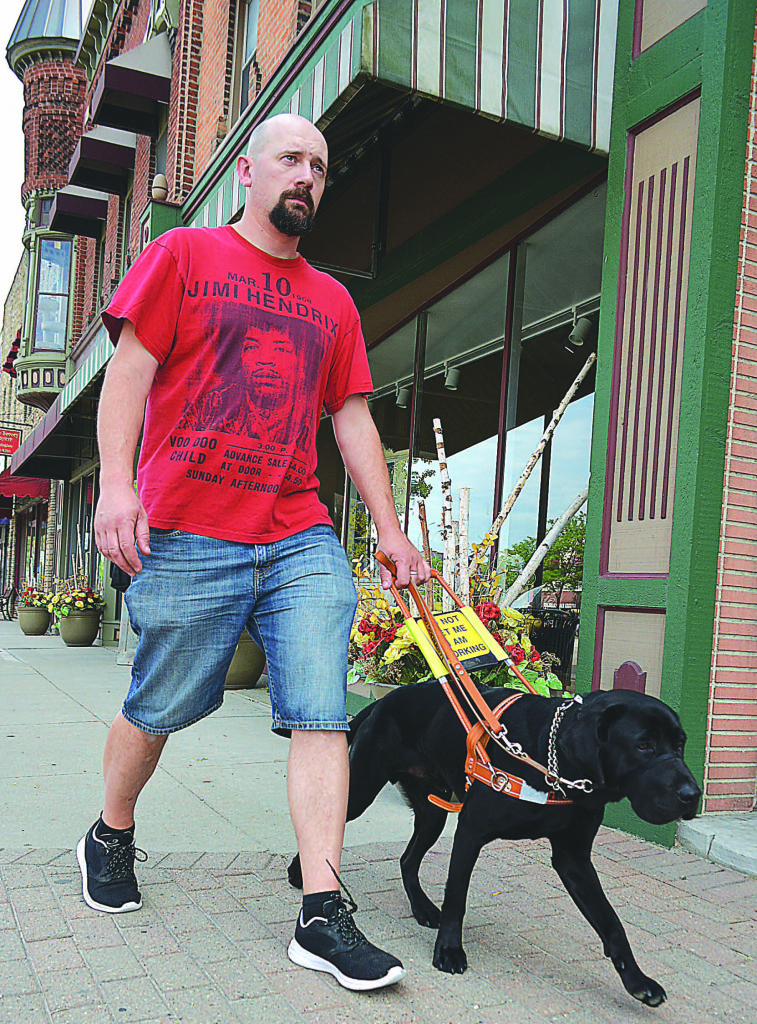
Photos by C.J. Carnacchio.
If you see Alex walking along the streets of Oxford, don’t pet him or offer him any treats.
He’s busy working and shouldn’t be distracted.
The 17-month-old black Labrador retriever is more than simply man’s best friend enjoying a stroll outdoors.
He’s a guide dog.
More specifically, he is Justin Willcock’s guide dog.
“He loves it. He looks forward to working,” said the Oxford Village resident, who is legally blind.
This is the Willcock’s first guide dog. On June 21, he brought Alex home from the Rochester Hills-based Leader Dogs for the Blind, a program designed to empower people who are blind, visually-impaired or deaf and blind by equipping them with skills “for a lifetime of independent travel.”
Having grown up in Rochester, Willcock was already familiar with the program that was founded in 1939 by three Detroit-area Lions Club members.
“I didn’t call anybody else. I went to them,” he said.
Willcock, who will turn 38 on July 3, has Usher syndrome, a condition that leads to hearing loss and an eye disorder known as retinitis pigmentosa (RP).
“RP causes night-blindness and a loss of peripheral vision (side vision) through the progressive degeneration of the retina,” according to the website for the National Institute on Deafness and Other Communication Disorders (NIDCD).
Critical for vision, the retina is a light-sensitive tissue located at the back of the eye.
“As RP progresses, the field of vision narrows – a condition known as ‘tunnel vision’ – until only central vision (the ability to see straight ahead) remains,” the NIDCD website states.
“Basically, it’s like looking through a straw,” Willcock said.
He noted his visual field – the total area a person can see without moving their eyes from side to side – is less than 10 degrees.
What Willcock can see is all based on contrast.
On bright, sunny days, the contrast gets “bleached out” by the “glare” and it’s difficult for him identify whatever he’s looking at.
Cloudy days are best because he can see more.
Night time is the worst.
“I can’t see anything at night,” Willcock said. “When the sun goes down, everything’s just black.”
Willcock began to experience hearing loss, which he described as mild to moderate, around the age of 5. He now wears digital hearing aids.
“I hear a lot more, probably, than before,” he said.
The vision loss didn’t come until his late teens/early 20s.
By the time he turned 30, Willcock was legally blind.
Being a stay-at-home dad with two boys – Jackson, 7, and Joseph, 4 – Willcock and his wife, Danielle, moved to a home on W. Burdick St. from Ortonville last August because he wanted to be more active and have places within walking distance.
“Ortonville has nothing really to walk to,” he said.
Willcock made the decision get a guide dog to help him navigate Oxford’s sidewalks and streets, and increase his independence.
He submitted his application to Leader Dogs for the Blind.
Leader Dog recipients must be at least 16 year old, legally blind, physically and emotionally capable of caring for a dog and agree to use the canine in the intended manner, according to the organization’s website www.leaderdog.org.
Thanks to the generosity of donors, there is no charge for Leader Dogs for the Blind’s programs and services, including the guide dog, equipment, training, transportation to and from its school, and room and board for the 25-day residential training program.
Willcock lived at the school from May 28 to June 21. He met Alex on May 31 and they’ve “been training hard every day since.”
“I had to be trained in how to use him, then we had to learn to work together,” he said. “There’s a lot of verbal and physical commands. They’re all simple commands.”
“He’s still a dog. He’s not a robot. He still has the instinct to look at another dog and sniff another dog’s tail. I have to control him,” Willcock added.
Prior to their meeting, Alex had already learned basic obedience and undergone guide dog training.
Leader Dogs are Labrador retrievers, golden retrievers, German shepherds or Labrador/golden crosses. A majority of Leader Dogs come from the organization’s breeding colony, but some come from other service dog organizations, according to www.leaderdog.org.
When they’re out in public and Alex has his harness on, his job is to help Willcock cross intersections safely, find curbs, avoid obstacles, and find doors, elevators, stairs, escalators and places to sit down.
“Sometimes he’ll take me around a crack (in the pavement) if it’s big enough that I might trip over it. He’ll walk me around it,” he said.
They have to work together to navigate the world around them. He can’t simply rely on Alex to do it all for him.
“It’s like a dance,” Willcock said. “He’s not going to stop at every single curb, so I’ve got to be aware of where we’re at. I’ve got to keep a map in my head and have a general idea of where things are. I’ve got to be alert. His eyes and ears are my backup. It’s a team effort.”
When they’re at home, the harness comes off and Alex is off the clock.
“It’s almost like a switch flips inside his head and he knows this is his relaxation time,” Willcock said. “He can’t be working all the time. This is where he can relax and just be a dog.”
Willcock couldn’t say enough good things about Leader Dogs for the Blind.
“It’s an excellent program,” he said. “The people there are extremely nice. They’re very patient, very understanding. It was nice living there . . . They make you very comfortable.”

So happy for you, Justin!
Your 2nd cousin in-law who shares your July 3rd birthday,
Joan Phillips
Absolutely love this! I was Alex’s puppy raiser for his first 5 months and have several puppy pictures if you’d like any! 🙂